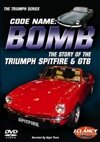Model Page
Triumph Spitfire 1500

|
Production Run: |
95,829 |
|---|---|
|
Production Date: |
1974 - 1980 |
|
Engine: |
Triumph 1,493cc Straight 4 |
|
Built: |
Canley (UK) |
|
0-60: |
12.5 secs |
|
Max Speed: |
101mph |

The Triumph Spitfire 1500 was based on the MkIV Spitfire that was introduced in 1970 by Triumph and was the final, most accomplished Spitfire produced. The styling of the MkIV was completed by Michelotti, he having been responsible for the designs of countless Triumphs; the car was in essence a re-skinned Mk3 Spitfire.

Triumph Spitfire 1500
The Triumph Spitfire 1500 was a rear wheel drive, front engine car mechanically similar to the earlier cars. The front suspension was independent coil springs and the rear suspension was independent with a transverse leaf configuration. The brakes were solid front discs with drums at the rear. The model was fitted with a four speed Morris Marina gearbox that was more suited to the task with revised gear ratios, electronic overdrive could be fitted to the unit as an optional extra.
The Spitfire 1500 featured a 1,493cc engine, this was an enlarged version of the 1,296cc engine fitted to the base models, the increase in displacement gave rise to a generous improvement in the torque generated by the unit making the driving experience much more civilised. The engine was fitted with twin SU HS4 carburettors in this guise the engine developed 71bhp @ 5,500 rpm and 82 lb/ft of torque @ 3,000 rpm. Unfortunately the 1500 engine was rougher and more prone to failure than the 1,296cc engine, the main reason behind this was the use of three main bearings for the crankshaft.

Triumph Spitfire 1500
The US market received the car with much less power than the Euro specification cars due to the more stringent emissions regulations. The US spec cars were fitted with a single Zenith-Stromberg carburettor and the compression ratio was reduced from 8.0:1 to 7.5:1 in order for the car to run on lower octane unleaded fuel. In addition the car was fitted with a catalytic converter and exhaust gas re-circulating system. In this specification the engine only developed 53 bhp, this increased the 0-60 time by around 1.8 seconds to 14.3 seconds.
To comply with US regulations that stated headlamps had to be at a certain height, the car was fitted with longer front springs, this also had the effect of adversely affecting the handling. The car suffered visually with the inclusion of wing mounted reflectors on both the front and back wings and large black plastic over-riders on the bumpers.
With British Leyland’s finances being in a perilous situation the car did not receive any major revisions during its lifecycle rather very minor updates. In 1976 to keep up with the trend of having matt black external fittings the stainless steel windscreen wipers and chrome door handles and mirrors were replaced with matt black units. In 1977 the steering column switchgear that was taken directly from the Triumph Herald was scrapped and replaced with the unit from the more modern TR7, during this model year the all vinyl seats were replaced with much smarter half cloth half vinyl items.
Optional extras included overdrive, a steel removable hardtop and special luxury trim pack that offered more interior padding.
The Triumph Spitfire 1500 differed from the Mk IV with the addition of a “1500 Spitfire” decal on the front bonnet and inside a centre armrest and knee pads were fitted on the propshaft tunnel.
The final Spitfire ever produced was in August 1980 and was a 1500 model painted in Inca Yellow, with factory hardtop and overdrive unit. The car went out of production due to the failure of British Leyland to invest in the Spitfire, rather they opted for minor revisions and facelifts. The Spitfire had been scheduled to remain in production until 1982, unfortunately the 1500 engine was unable to comply with emissions laws in the US to which 50% of production was shipped. This in turn would drastically reduce the sales of the car, and with the spitfire no longer sharing a platform with other models in the BL range production became uneconomical.
The Facts
|
Engine: |
Triumph 4 Cylinder |
|---|---|
|
Capacity: |
1,493cc |
|
Valves: |
8 |
|
Compression Ratio: |
9.0:1 |
|
Fuel System: |
Twin SU HS4 Carburettors |
|
Maximum Power: |
71 bhp @ 5,500 rpm. |
|
Maximum Torque: |
82 lb/ft @ 3,000 rpm. |
|
Transmission: |
Manual 4 speed (Optional Overdrive) |
|
Top Gear: |
18 mph per 1000 rpm / 22.6 mph in overdrive |
|
Brakes: |
Solid Front Discs / Rear Drums |
|
Kerb Weight: |
808 Kg |
|
Max Speed: |
101 mph |
|
0-60: |
12.5 secs |






